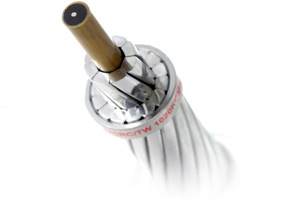Strongest, Lightest and Most Efficient Transmission Conductor in the World
Energy Technologies International is contributing to the Smart Grid movement through a new line of composite products built around the High Voltage Composite Reinforced (HVCRC) Smart Conductor. Through more than 10 years of research and development by industry-leading engineers and scientists, ETI developed a way to greatly improve transmission capacity through a patented composite core for use in transmission conductors.
With its innovative design, HVCRC replaces the steel core strength component of a traditional aluminum conductor steel reinforced (ACSR) transmission line, with a non- metallic composite core. This enhanced product allows for increased transmission capacity of up to 2 times that of traditional lines, while lowering line losses, limiting sag and requiring less infrastructure costs to deliver more.
Global Energy Partners Choose Energy Technologies International for HVCRC
After proving CFCC/HVCRC through rigorous testing protocols, several leading energy industry firms have formed alliances with Energy Technologies due to our superior product and recent patent awards in the United States and worldwide. These firms include: LS Cable & Systems, Wuxi Huaneng Electric Cable Company, Hindusthan Urban Infrastructure, Citra Cable and Epsilon Composites.
One of the key design factors to the CFCC/HVCRC Smart Conductor’s drastically improved ampacity stems from the composite core’s use of compact shaped aluminum strands, which allows more conductive material at equal diameter line configurations.
Additional benefits of composite vs. steel reinforced cables are:
Reduced Sag
CFCC/HVCRC experiences less sag than the traditional ACSR distribution lines due to its lighter weight and higher temperature tolerance. CFCC/HVCRC is tolerant up to 150 degrees Celsius continuous use, reducing heat-induced sag in periods of peak demand. Reducing sag is a key factor in increasing ampacity during the transmission process.
Lower Resistance & Greater Ampacity
Engineered from non-metallic materials, CFCC/HVCRC does not suffer from inductive interference like ACSR and ACSS. This reduced interference lowers line losses, significantly leading to more electricity delivered or lower power generation needed. By using pre-annealed trapezoidal shaped aluminum strands, CFCC/HVCRC conductors have 28 percent more aluminum in comparable sized conductors, allowing for significantly more ampacity to be delivered in the same transmission corridor or on a per line basis.
Durability
Engineered from non-metallic materials, CFCC/HVCRC is not affected by corrosion, a typical problem with conventional transmission cables. Salt, air pollution and galvanic corrosion from metal on metal contact all play a role in weakening traditional steel cores over time. Our world class production team has consistently produced results that dwarf our competitors and set new standards for quality.
Tensile and Flexural Strength
Unlike some composite conductors, the composite core of a CFCC/HVCRC line is not brittle or fragile. Consequently, they can be wound around standard reels (with appropriate bend radius) and handled by workers and linesmen without the need to employ special handling procedures for installation and can be pulled to the appropriate tension with a standard pulley system. Based on published results, CFCC/HVCRC is the strongest conductor available in the market.
Cost Efficiency
HVCRC exhibits less sag, so they can cover much greater spans than other cables pulled to the same tension. As a result, fewer poles and towers are required in the design of CFCC/HVCRC lines, which along with lower line losses, reduces costs for both distribution companies and consumers.


